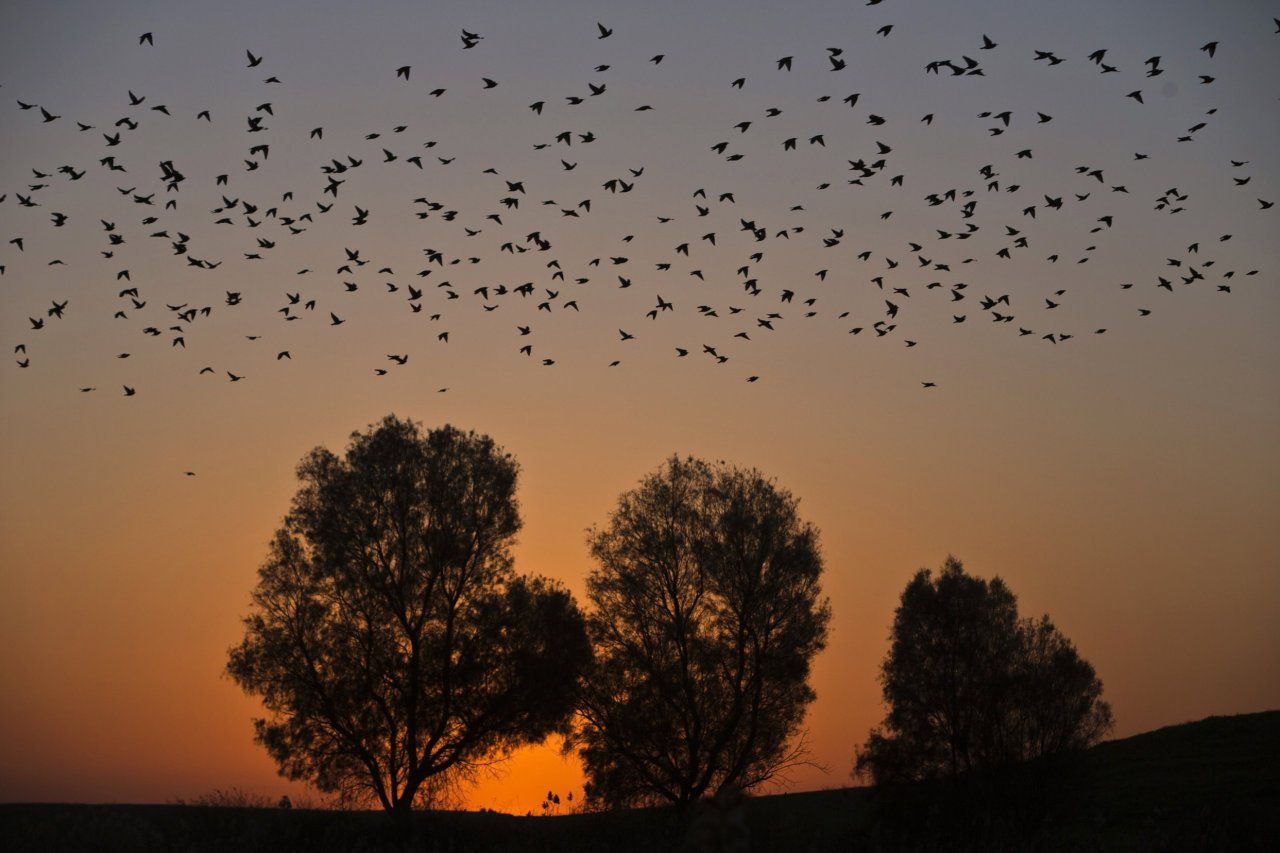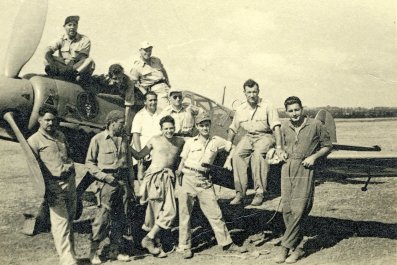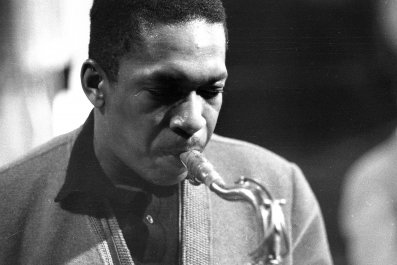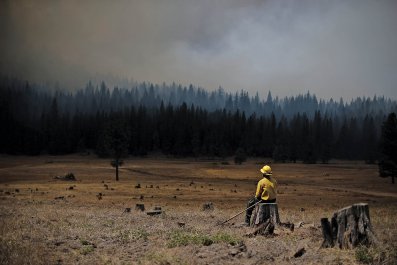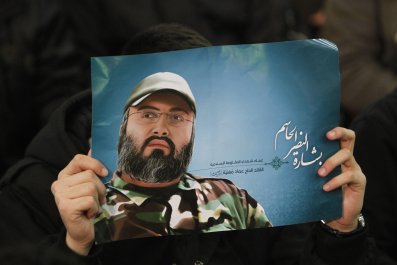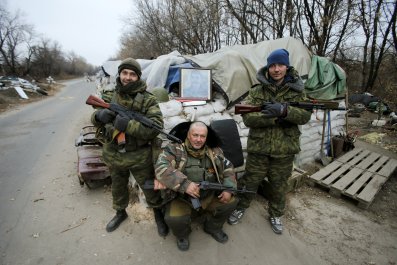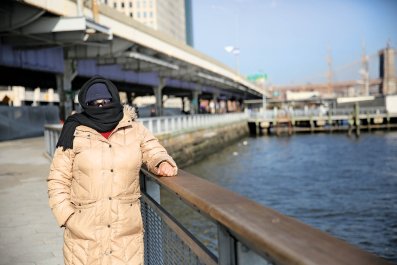Resting on one knee, the hunter poses for the camera, his kill laid out in rows of 20 before him – birds ordered neatly into their respective species. The rarest are placed at the sides; red breasted geese, shelducks and a single sandpiper flanking dozens of coots, teals and white fronted geese.After the camera shutter snaps, the birds are quickly packed into plastic sacks. Before the end of the day, they will be skinned, drawn, packed and frozen in preparation to be smuggled overland to Italy. Within 48 hours, many will have been sold on the black market to Italian restaurants who will offer them up as traditional Italian fare.
Later in the day, I am sitting in a café in a small north Serbian village a few miles south of the slaughter, waiting for Milan Ruzic to get off the phone to the local police. He's a conservationist with the Bird Protection and Study Society of Serbia (BirdLife Serbia) and he's furious because the hunter has posted the photo of the dead birds on Facebook. "You can go to jail for shooting these birds, and this man is advertising his own crime on Facebook. Yet the police don't want to know."
Before dawn that morning at a small fish farm in north-east Serbia, Ruzic and I had watched as more than 20 Italian hunters encircled the lake and waited for daybreak. As the sun came up, thousands of birds rose with it, ascending from the water like mist and then breaking into the formations particular to each species before heading to the fields for breakfast. But once the shots started, all order was lost. The birds fell into a frenzy, doubling back on themselves again and again, swerving violently from the noise and falling with increasing regularity as the hunters perfected their aims. By 10am, the game keeper began the long trawl for the dead.
Of the five billion birds that fly through Europe each autumn to spend winter in Africa and the warmer countries north of the Mediterranean, up to one billion are killed by humans. Along the Mediterranean coast, recorded birdsong blasts out of speakers, drawing swarms of songbirds into the lines of near invisible nets that hang between trees. Sticks smeared with glue are positioned among the lower branches of trees to provide attractive perches. Poisoned prey is laid out for raptors. Spring loaded nets for water birds. Then there is the army of hunters, tens of thousands of whom descend on the Balkan countries each autumn, positioning themselves along the migratory corridors and setting up camp in the spots where birds come to rest.
With the use of highly effective electronic decoys that mimic the sound of the birds, a single, efficient hunter can kill up to a hundred water birds by lunchtime. In Romania, a hunt manager boasts that the record for songbirds shot by one of his clients is 400 in a day, all felled from the comfort of a fold-out chair in a wheat field shortly after harvest. They kill for fun, a ramped-up version of centuries-old traditions, but also for money: every bird shot or trapped can be sold. Water birds and songbirds go to restaurants; raptors are stuffed and sold over the internet as ornaments.
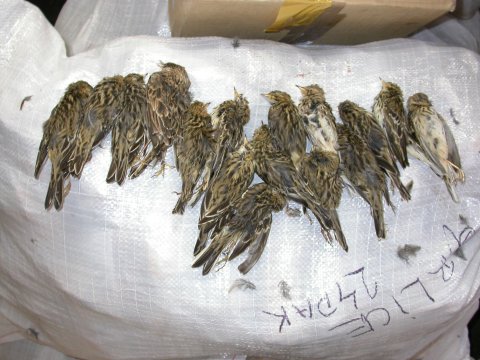
Within the borders of the EU, birds have had special conservation status since the creation of the landmark Birds Directive in 1979, a policy designed to protect the populations of all bird species from hunting and habitat loss. For hunting, the directive is strict on paper but far looser in reality: all but a handful of bird species are illegal to hunt until exemptions are requested by individual member states, when they are invariably granted. As a result, a bird can be served up legally in a restaurant in France, while its killer would be jailed in the UK. This makes life particularly tricky for bird traders – a mistle thrush, for example, can legally be shot in Romania to be sold in Italy, but cannot be transported through any of the countries that lie in-between.
Song Bird Slaughter
After a few mornings in Serbia, the crackle of gunshot becomes as much a part of the wetland soundscape as the call of birds. But not once do I see a Serbian with a gun. Ruzic has spent the last decade tracking hunters in Serbia and collecting information to try and lure the government into action. "It's Italians who run the show here," he explains. "Serbians hunt when hungry. It was a bad time for birds following the war in the 1990s. But only Italians hunt here when things are going well."
All across south-east Europe but particularly in Romania, Serbia, Albania and Bulgaria, Italian hunters have become public enemy number one for bird lovers and conservationists. Since the collapse of communism 25 years ago, each year sees more and more Italians heading east to shoot birds. Their sport is organised by Italian-owned companies, hundreds of which have sprung up in recent years, often registered in the tax havens of Malta or Cyprus. Hunters often stay in Italian-owned, or Italian-staffed hunting lodges. And almost every bird shot is thought to be illegally smuggled back home where it is sold at a mark-up of up to 3,000% on the black market to supply the unquenchable demand for wild bird recipes such as polenta e osei – polenta with grilled songbirds – sold in restaurants throughout the Italian countryside.
"Many Italians, particularly people from the countryside, think of bird hunting as an unalienable tradition," says Marco Avanzo, chief of the Italian forestry police. "They argue that it is their way of connecting with nature, the rural way. It has already caused chaos to Italian wildlife, but now with the mix of new hunting technology, economic incentives and open borders through Europe, the problem is growing and spreading. The demand for hunting and wild bird dishes is huge in Italy, and so hunters are following the market to where laws are lax and birds come cheap and plentiful."
According to a 2008 report published by TRAFFIC, a wildlife trade monitoring network, the hunting and smuggling of wild birds to Italy "involves highly organised criminal activity in south-east and Central Europe. Hundreds of thousands of songbirds are illegally shot and exported every year. The industry as a whole is estimated to be worth around €10m a year". But many believe TRAFFIC underestimates the scale of the trade. A few years before the report was released, a single sting by Italian border police found 120,000 songbirds crammed into a single truck coming from Serbia. The trade was organised by two companies which offered hunting tourism to Italians.
In the trial that followed in the Italian Courts, these companies were found to have smuggled over two million birds into Italy from Serbia over a six-year period. Each of these birds would fetch anywhere between €5 and €150 on the black market. The Serbian government was sent a note by CITES, the international body for monitoring the trade of wildlife, pointing out that many animal products were worth more on the black market than cocaine or heroin.
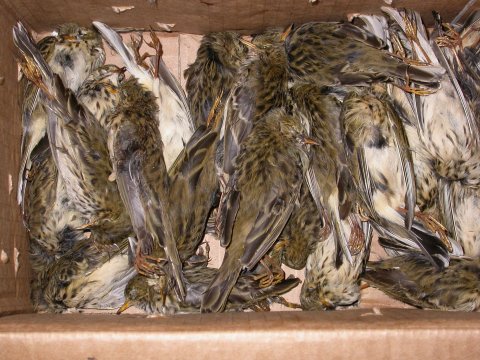
In the years since, little has changed. If anything, the poaching and smuggling problem has increased. A local hunter complains over coffee that the Italians have the police and authorities in their pockets. Under condition of anonymity, he says: "They work outside the law. They get access to the best spots where they shoot as much as they want of anything they want. All payments are in cash, so they are off the record. When the police occasionally turn up because someone has complained of poaching, resolution (for the poachers) is never more than a phone call away. Simply, it is a mafia."
Mafia Lobbyists
Everyone working in conservation seems to have settled on the term mafia as the best description of the network which runs the trade.Katalin Kecse-Nagy, an officer at TRAFFIC, points to the way birds are transported to Italy. "Mules or couriers store birds, often skinned and beheaded to avoid identification, in special compartments that are built into cars and trucks. Then they make a dash for Italy. These are the tactics of criminal gangs," he says.
Then there are those running the show, a shifting network of Italian businessmen who own the hunting agencies, organise the transfer of the animals and arrange their drop off in Italy. A source from the environmental arm of the Serbian government explains: "It's mostly individual Italians with strong contacts in local administrations. They employ local Serbians who know the right spots and the right people, and who know when to look the other way."
Ruzic has tried fighting the hunters through official channels. "The hunting lobby is closely intertwined with the industrial lobby," he says. "Many of the hunters here are also investors, and even where they're not, the Serbian government is keen to keep the Italian community on side. This is the government's idea of making new friends." But Ruzic has another plan. Over the last year, he and a team of two volunteers have spent more than 900 hours scanning the Facebook pages of Italians who come to Serbia to hunt. At the end of a day's shooting, tradition demands that each hunter has his photo taken with his kill laid out in front of him, often regardless of the legality of the quarry.
"They just can't resist posting what they're up to on Facebook," says Ruzic. "It makes it very easy for us to get a good idea of what is being killed, and what is being smuggled out of the country. Last year for example, 45,000 quails were shot officially. Through Facebook, we found another 70,000 or so had been poached. The records show that only a few thousand stayed in the country, so the chances are everything else is going back to Italy. The problem though is what to do with the data when the police and customs aren't interested."
The Perfect Ambush
Meanwhile, in a small Croatian town near the Serbian border lives an environmental inspector called Zeljko Vukovic who has shown how quickly the poaching and wildlife smuggling industry can crumble when the authorities give the reigns to the right people. In just over a decade, he has caught so many poachers that Italians now avoid the country almost altogether. On the borders, he launched a training programme for customs inspectors, teaching them to spot and search potential wildlife traffickers and identify the birds they find, even when they are skinless, headless and frozen in cubes of water. As a result, the number of seizures of birds on the Croatian borders has dropped from being almost weekly occurrences at the turn of the century to almost none today.

Before we meet at his bungalow in a quiet cul-de-sac in Djakovo, Croatia, I am warned to tread carefully around him. He is a war veteran who fought with the Special Forces in the Yugoslavian war. His whole family are black belts in various martial arts. After a few years as a police officer, he started working as an environmental guard, tracking and arresting poachers: "I invented the job. Poachers were everywhere. No one was doing anything about it. At first I had to work between 9am and 4pm, like I was an accountant. No one hunts at this time. So I fought with my superiors until I had complete control, the highest ranking you can get in the police force."
He began to assemble a network of informers around him. "I got birders, environmentalists from NGOs and even hunters on my side. They are my eyes. They tell me when something is going on. When I get the call, I am brutal. I show no mercy. I wait until night time and then, with a team of policemen, we go to the spot where the poachers have been, find a somewhere to hide and wait to ambush. We wear Kevlar vests and carry AK-47s. You know when the poachers are coming because you hear their dogs, but they don't know you are there until you are on them."
In 13 years on the case, Vukovic has caught more poachers than he can remember, but says he has only twice come across Croatians shooting birds. "They are normally important, successful people, and almost always they are Italian. I have caught policemen, military personnel, diplomats, businessmen, doctors – I caught Henry Kissinger's surgeon poaching with a gun worth €25 000."
The smuggling problem is harder to solve. Vukovic believes that at least 80% of all birds shot in Romania and Serbia find their way back to Italy even if they can not pass through Croatia. "There are other ways to get there. If they can get to the Mediterranean they are just a two hour boat ride away from Italy. And it is easy through countries like Bosnia and Montenegro, which have barely any customs control."
'A Massacre for Perverts'
When Italian hunters fly to Romania, they pack light. Typically, a single suitcase will hold a pair of binoculars, an outfit of army surplus clothing, a wad of cash in euros, and two or three empty holdalls. On the return flight, the holdalls are checked in through customs, each heavy with hundreds of songbirds. Anomalous to the rest of Europe, in Romania and Italy the law stipulates that for each day a hunter shoots while in Romania, he is entitled to take 100 skylarks back with him to Italy by plane. If someone shoots straight for a full week, he can take home 700 birds.
But when I ask Daniel Raffaelli, co-owner of the hunting company Raffaelli Caccia Romania, how many birds I could take to Italy with me after a proposed three-day hunting trip, he says: "If you are flying, you can take 500, 1000, however many you want. All you have to do is pay the price of the luggage, we do the rest." What about protected songbirds such as goldfinches or wagtails? "Don't worry about that. We will arrange the birds for you," he says.
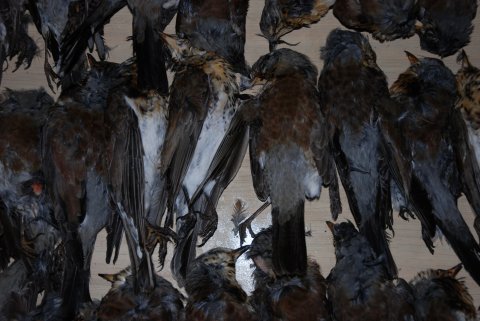
Over 30 days in September and October each year, 10,000 Italians fly into Romania to shoot skylarks as the birds gather for migration over the newly-harvested crop fields that stretch, unbroken by woodland, from the edge of the Carpathian mountains to the coast of the Black Sea. Hunting companies rent out picnic chairs, automatic shotguns and electronic devices that mimic the hyperactive call of the skylark, drawing in huge flocks to within metres of where the hunters sit, blasting indiscriminately at the sky.And yet when I ask the manager of one hunting company if he hosts skylark hunts, he barks at me, outraged: "It is not a sport! It is a massacre for perverts!"
Romania is the only country in Eastern Europe where skylarks can be shot legally, and the Romanian government has been exploiting this niche in the market. This year, the hunting quota for skylarks has been set at nearly 700,000, which, according to EU statistics, is well over a third of the country's entire skylark population.Tamas Papp at Milvus Group, a Romanian wildlife protection organisation, is part of the team that monitors the skylark population. "I don't think the government has even looked at the population statistics. The hunters just give the number that they would like to shoot, and the government signs the page. The quota acts like an umbrella to permit the shooting of other protected species as well; if you can kill skylarks, you can get away with killing anything of songbird size. Goldfinches, pipits, linnets, wagtails and others all come under fire."
Rambo with Birds
At a court in Constanta, a crumbling port town on the Black Sea coast, three Italian hunters and a Romanian currently are standing trial for organising the massacre of thousands of songbirds. The prosecutor working on the case, a burly, hardened man with smiling eyes called Teodor Nita, describes the hunt to me over Skype: "There were 20 hunters involved, each one shooting many hundreds of birds, any and every type of bird they could. They just sat there shooting, piles of empty cartridges around their chairs. Have you seen Rambo? Swap the Vietnamese for little birds and you've got the picture." The Italians, Nita says, will likely get three to five years each in a Romanian jail. The Romanian – a man called Miron Danut – will go down for 12 years for tax evasion and abuse of power. "It's the Romanians who run the show," says Nita. "Without corrupt Romanian administrators, the Italians can't do anything."
All across the Romanian lowlands, court cases like this are running through the Romanian courts, and it is always the Romanian administrators who fall the hardest. But while the police are closing in on poachers, the Romanian government is making their life easier by loosening hunting laws. This year, quotas for almost all legally huntable birds have gone up, even where populations have been shown to be falling. In the senate, a law is being pushed through to expand the hunting range into protected areas, including the Danube Delta, home to Europe's most diverse waterbird population. Speaking out against hunting in Romania has become a form of political suicide. Even NGOs watch their step. When I meet a government employee in Bucharest, he makes me promise to grant him complete anonymity then proceeds to speak in a near whisper, shifting edgily in his seat. "Hunters are everywhere in Romanian politics and they are all looking out for their friends in the hunting business. Even though Romanians don't shoot songbirds, they know there is a lot of money to be made from Italians looking to shoot songbirds so they arrange the laws in their favour. Even the politicians who don't hunt are keen to keep Italian hunters happy. Italy has invested heavily in Romania over the last few years and government will do everything it can to keep them happy."
The Emptiness
On either side of the Carpathian mountains, you can travel hundreds of kilometres and count the trees you pass on your fingers. Vast strips of crops grow in monocultures, patterning the land like a Mondrian canvas, painted in pastels. The Hungarians call these plains the puzta – which translates directly as "the emptiness". It was across these plains that Milan Ruzic leads me on my last evening in Serbia, zig-zagging along the edge of fields towards a lone strip of poplar trees, through which the blackened surface of a lake can just be seen. The coarse hum of calling waterbirds grows louder and Ruzic is speaking quickly. "This is the only lake around here where no one hunts, and at night it gets so full with birds that you can hardly hear each other speak over the racket."
By the time we arrive, the light has almost left the sky but the birds are still coming. The surface of the lake is occupied by common cranes, standing stock-still in the shallows, heavy bodies delicately perched. Thousands more are descending from above, screeching as if under attack. Herons and cormorants hug the edges. Lapwings fly clumsily above. There must be over 30,000 birds in all, crammed into a space of no more than five hectares, the only available refuge from the fire of hunters. After we leave, I tell Ruzic that the lake reminds me of Hitchcock's horror film The Birds, that there were somehow too many birds, like they were about to turn against us.
"That's actually pretty normal," he says. "We often make nature the enemy. We invent excuses to believe that it is somehow unnatural. But what you've just seen is what can happens when we let things be."



